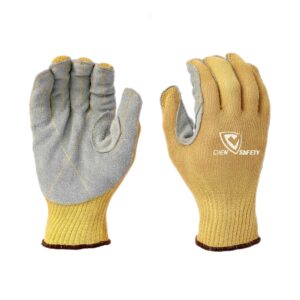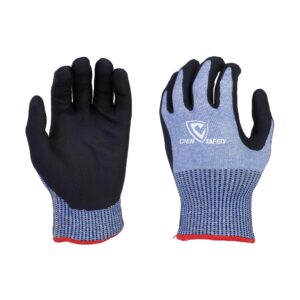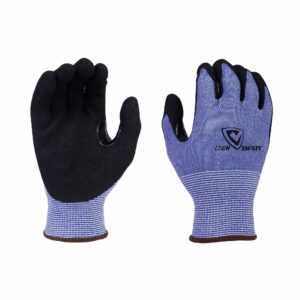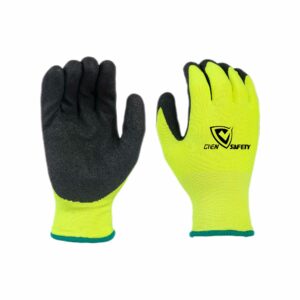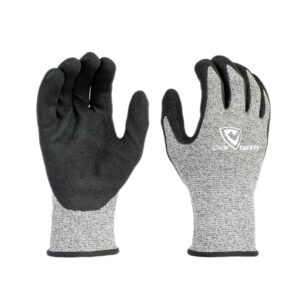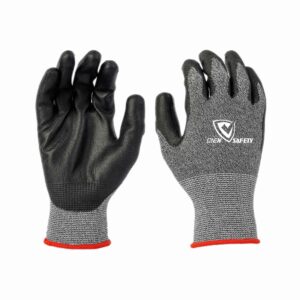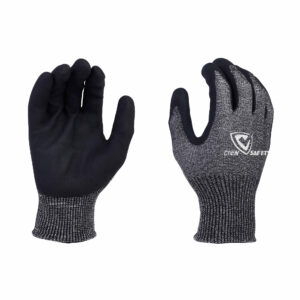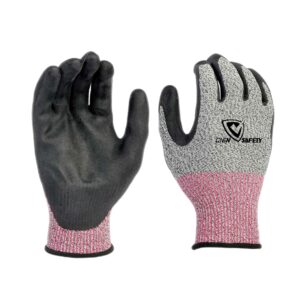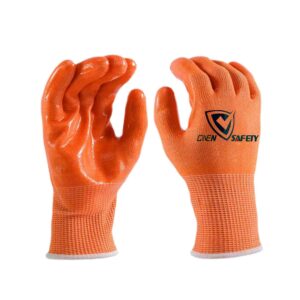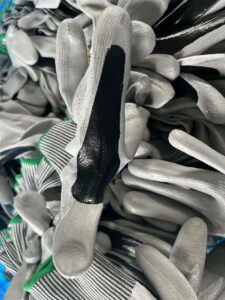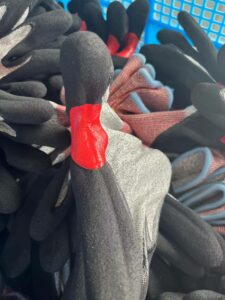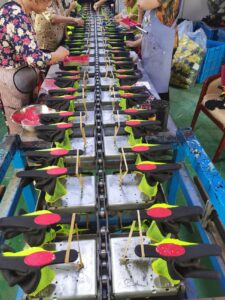Professional Cut resistant gloves manufacturer & supplier in china
Over 15 years of cut resistant gloves OEM experience
Wide range of coating and yarn options
Free samples design and making within 15 days
ANSI/ISEA105-2016: A1-A9, EN388: A-F
Factory direct price, small batch trial orders accepted
Do you have the following problems with your current bulk cut resistant gloves?
- The cut level is not stable.
- Feel too thick, too hard and uncomfortable to wear.
- Poor abrasion resistance, poor tear resistance, unstable quality.
- Higher price.
Features of Cut Resistant Gloves Made by Givensafety
- Stable cut level.
- Soft, close to the hand, breathable and comfortable.
- Super grip
- CE certificated
- Competitive price
- Custom your unique cut resistant gloves according to your industry and ideas.
What type of cut resistant gloves we can produce for you
If you have a cut resistant gloves project or you want to purchase or wholesale cut resistant gloves in bulk for a long time, then Givensafety Gloves will be a very good choice. Cut resistant gloves is one type of work gloves that Givensafety is best at manufacturing. High quality and reasonable price will make your cut resistant gloves more competitive in the market. Contact us now!
Different cut levels
ANSI/ISEA 105-2016
A1 Cut Resistant Gloves, A2 Cut Resistant Gloves, A3 Cut Resistant Gloves
A4 Cut Resistant Gloves, A5 Cut Resistant Gloves, A6 Cut Resistant Gloves
A7 Cut Resistant Gloves, A8 Cut Resistant Gloves, A9 Cut Resistant Gloves
EN388
Cut Resistant Level A Gloves, Cut Resistant Level B Gloves, Cut Resistant Level C Gloves,
Cut Resistant Level D Gloves, Cut Resistant Level E Gloves, Cut Resistant Level F Gloves,
Level 1- Level5 Cut Resistant Gloves
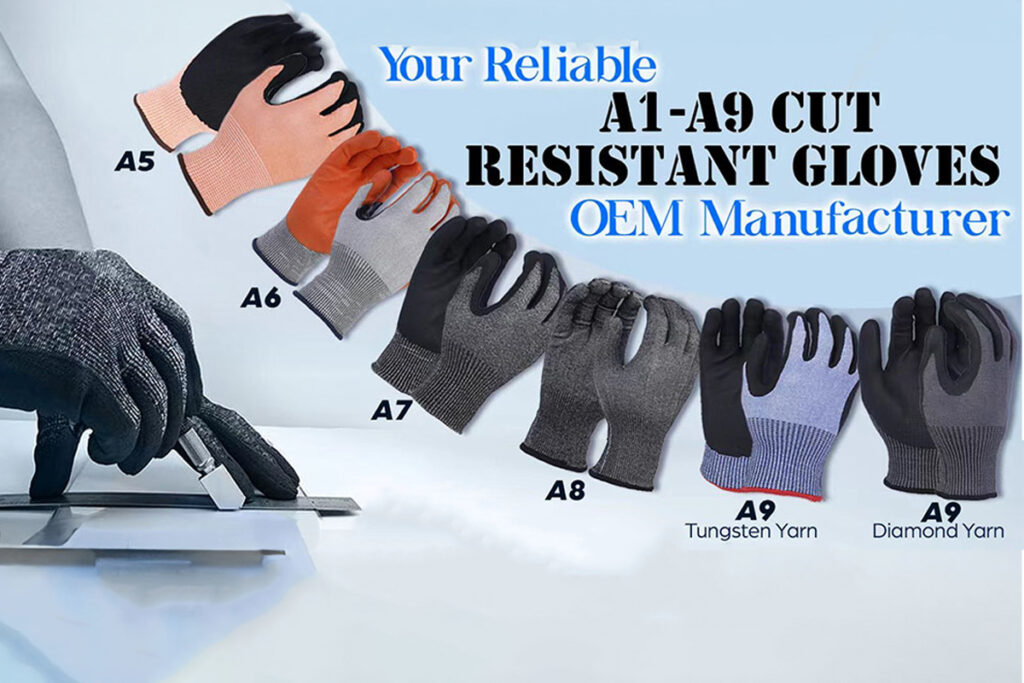
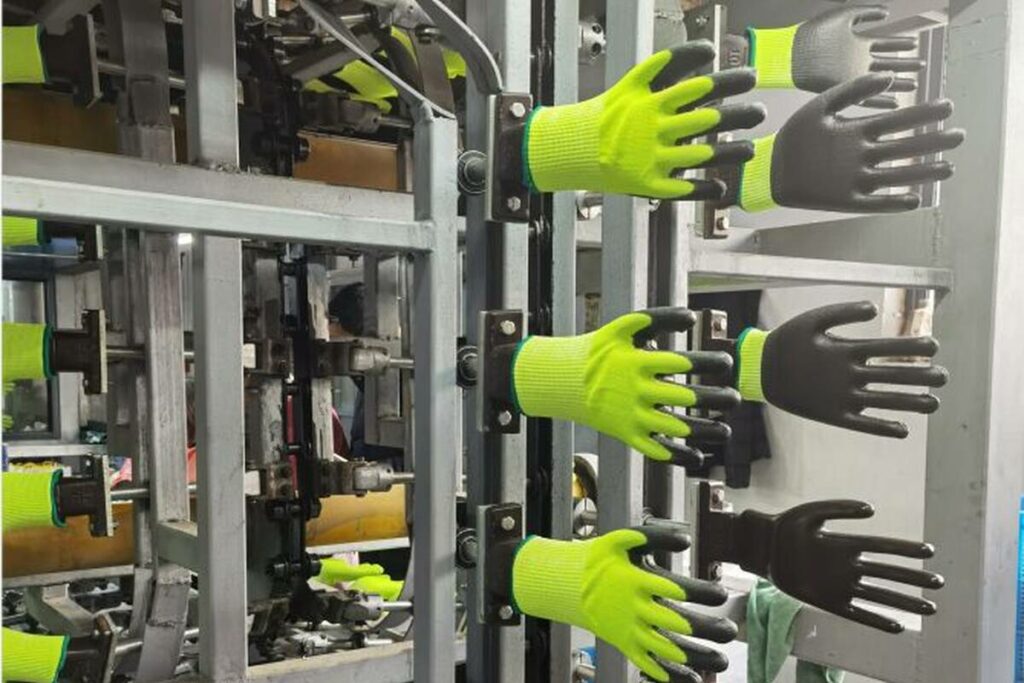
different coatings
PU Coated Cut Resisitant Gloves
Sandy Nitrile Coated Cut Resisitant Gloves
Foam Nitrile Coated Cut Resisitant Gloves
Smooth Nitrile Coated Cut Resisitant Gloves
Silicone Coated Cut Resisitant Gloves
Latex Coated Cut Resisitant Gloves
kevlar Cut Resistant Gloves
Leather Cut Resistant Gloves
Different gauge
Gauge: 13G, 15G, 18G, 21G
Color: As your requirements
Liners: HPPE, nylon, spandex, polyester, glass fiber, steel fiber, carbon fiber, acrylic, basalt fiber, aramid, Kevlar, etc.
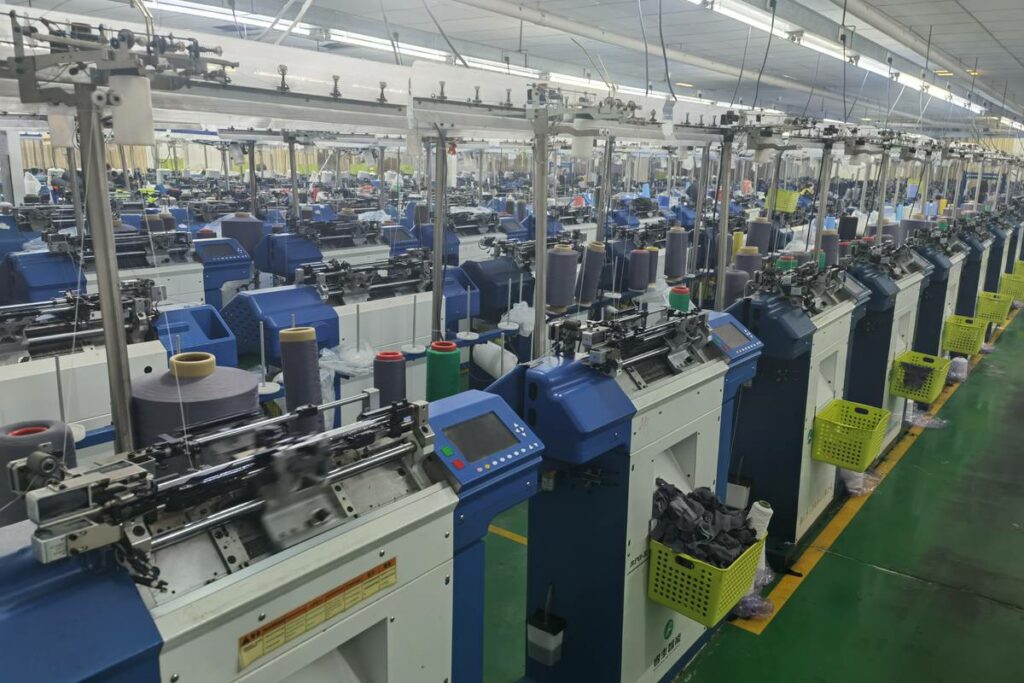
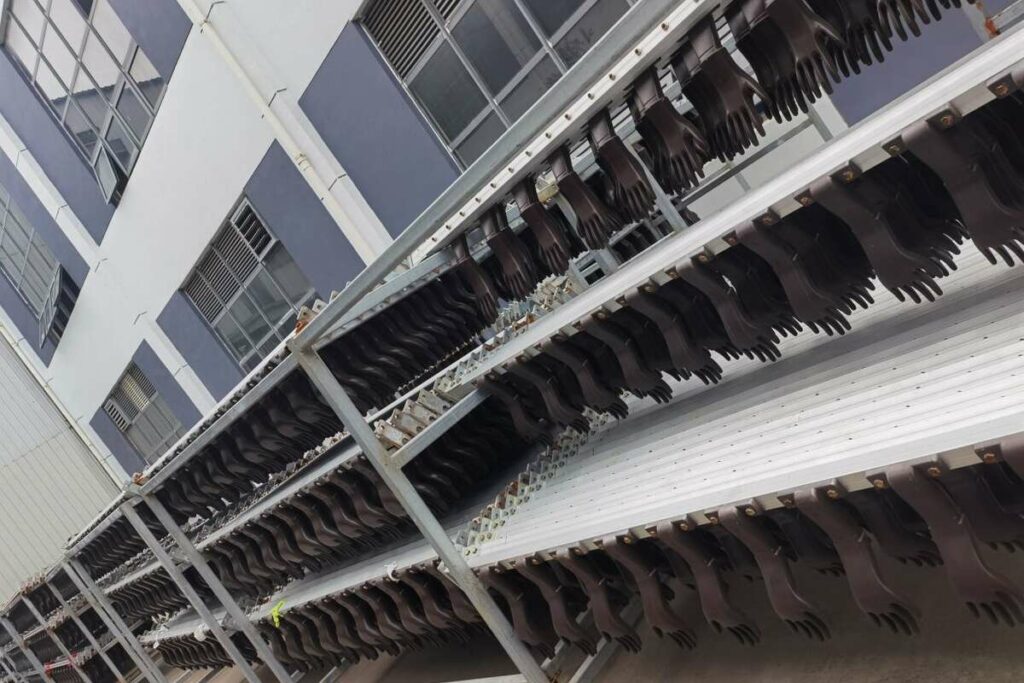
Different Size, Design, Packing, Functions And Application Requirements
Size: 6-12
Application: Automobile manufacturing, metal processing, construction, logistics and transportation, glass factories, slaughter plants, etc.
Functions: Cut resistant kitchen/restaurant gloves, cut resistant waterproof gloves, cut and heat resistant gloves, puncture resistant gloves, cut resistant gloves food grade, cut resistant butcher gloves, cut resistant gloves level 5, etc.
How can we guarantee the quality of your cut resistant gloves?
TOP 10 cut resistant gloves manufacturer & supplier in china
high quality glove materials
1. HPPE: The PE fibers we used removed the beginning and the last part, only the middle part is kept, so as to ensure the PE fiber stable strength and thus the stability of the cut level.
2. Steel Fiber: We use high strength but thinner steel fiber. Such as A5 cut-resistant gloves, we use 0.035mm steel fiber, which can not only achieve the A5 cut level, but also make the gloves softer and more comfortable. However, many factories use 0.05mm ordinary steel fiber to reduce costs.
3. Covering Workshop: The production environment is constant temperature and humidity. All glove yarns are placed in the workshop for at least 48 hours before wrapping to adapt to the temperature and humidity of the workshop, so as to maintain the tension and strength of the yarn to the maximum extent.
High and consistent dipping quality
1. Nitrile from Korea and Taiwan
PU from the famous brand PFT
Latex from Thailand
2. Fully automatic dipping line and technicians with 5 years of dipping experience ensure the best and most stable dipping quality.
A good dipping quality will give the glove a higher abrasion resistance and service life.
Strict quality control system
Given Safety now has two glove factories, where our respect for quality is present in every production process. Because quality is our first belief.
Good product quality makes our partnership strong and lasting.
We have successfully established a system of responsibility and problem tracking for each production process, and this system ensures the quality of each production step. We are capable to produce the best cut resistant gloves for you.
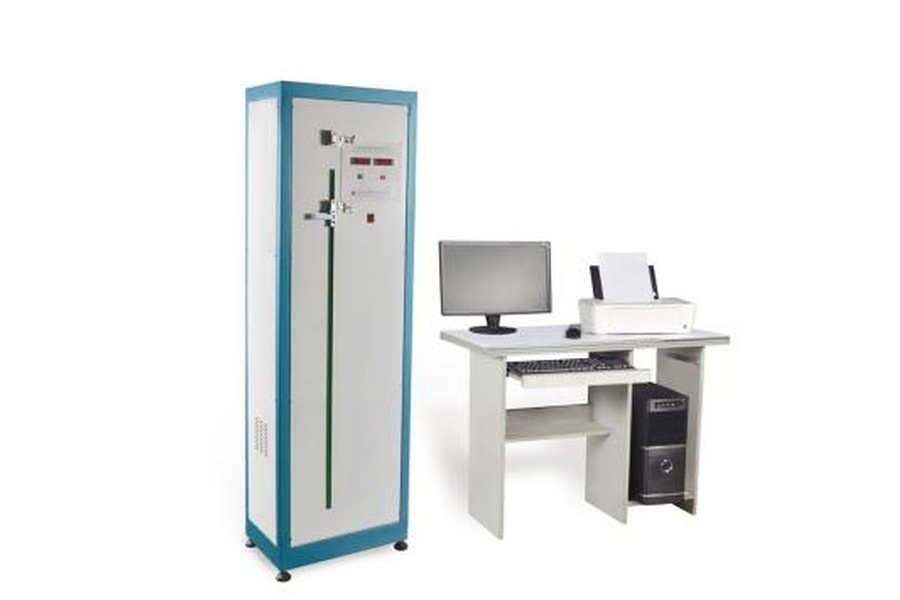
Yarn Strength Tester
The yarn is fundamental to the quality of cut resistant gloves.
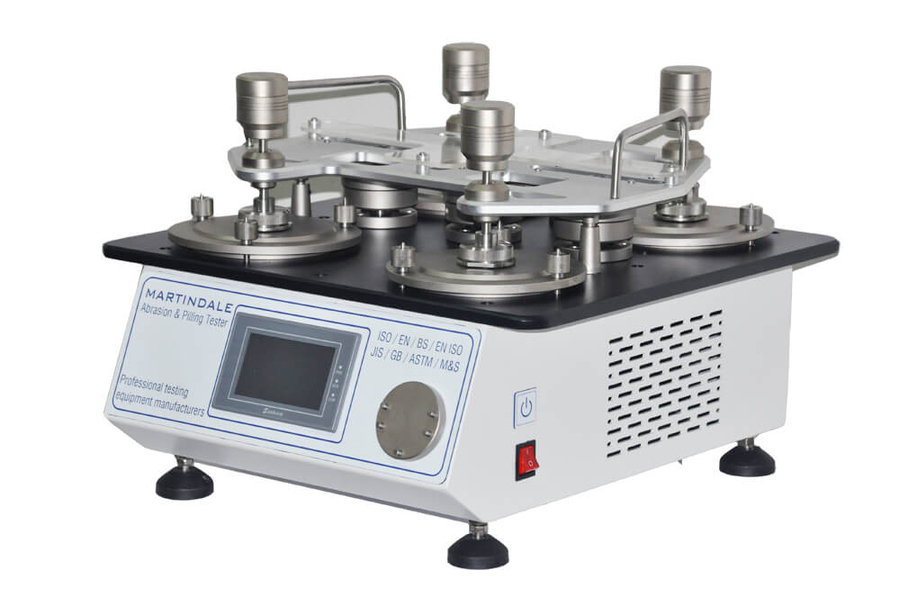
Abrasion Resistance Test
Abrasion resistance affects the service life of the glove. The higher the abrasion resistance level, the longer the service life.
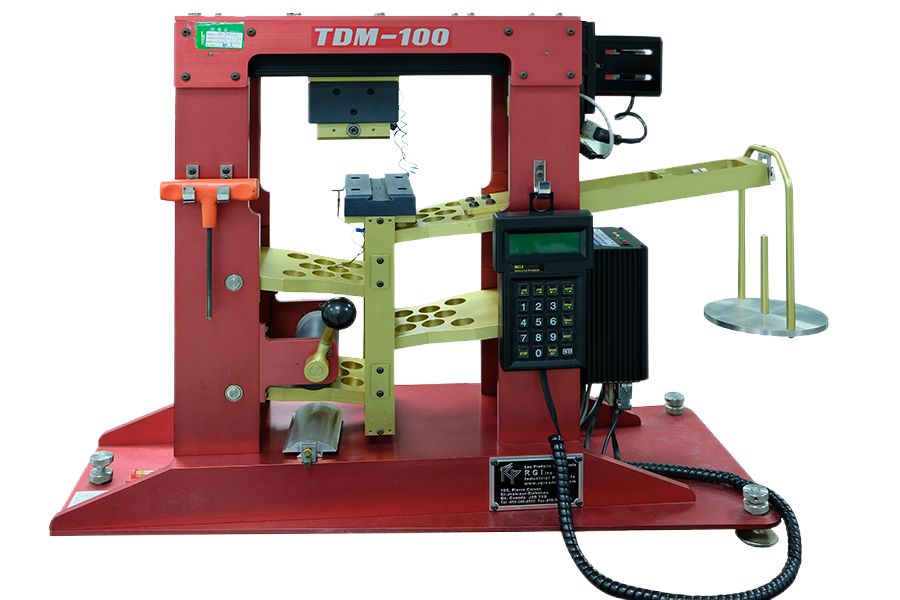
TDM Cut Resistance Test
ANSI/ISEA 105(2016): A1-A9
EN388: A-F
The higher the rating, the better the cut resistance.
Testing Center
We attach importance to the performance testing of our gloves, which range from raw materials to finished products.
We rely on scientific inspection data to judge the quality of our gloves. We can assist you with professional performance testing of cut proof gloves at a third party.
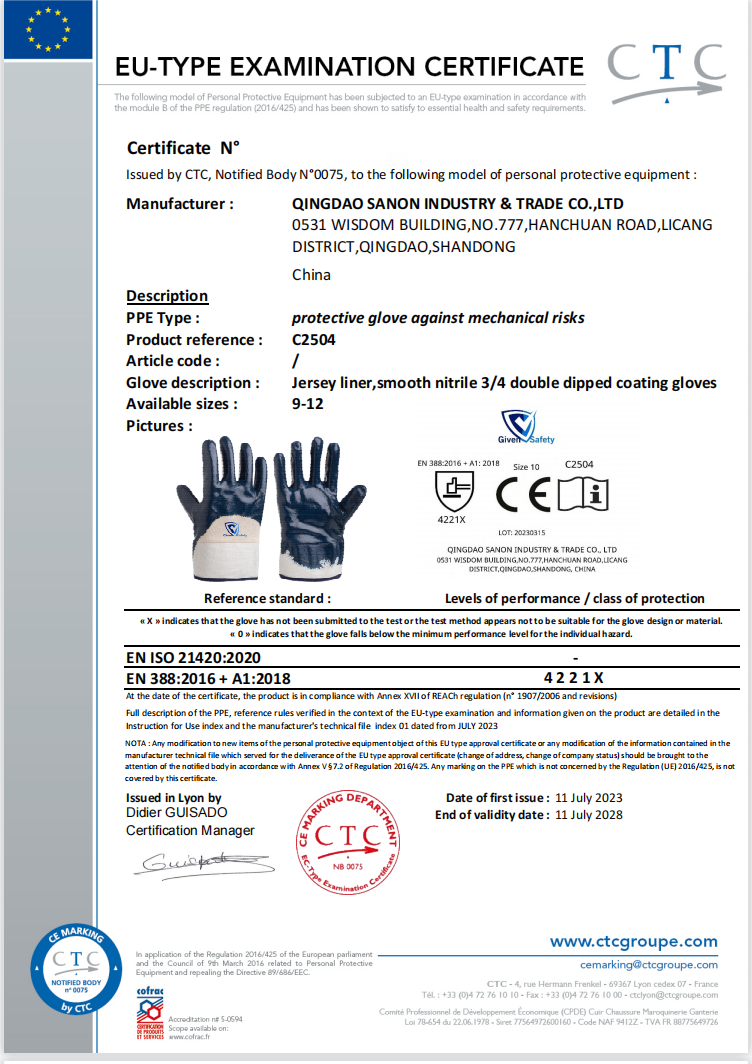
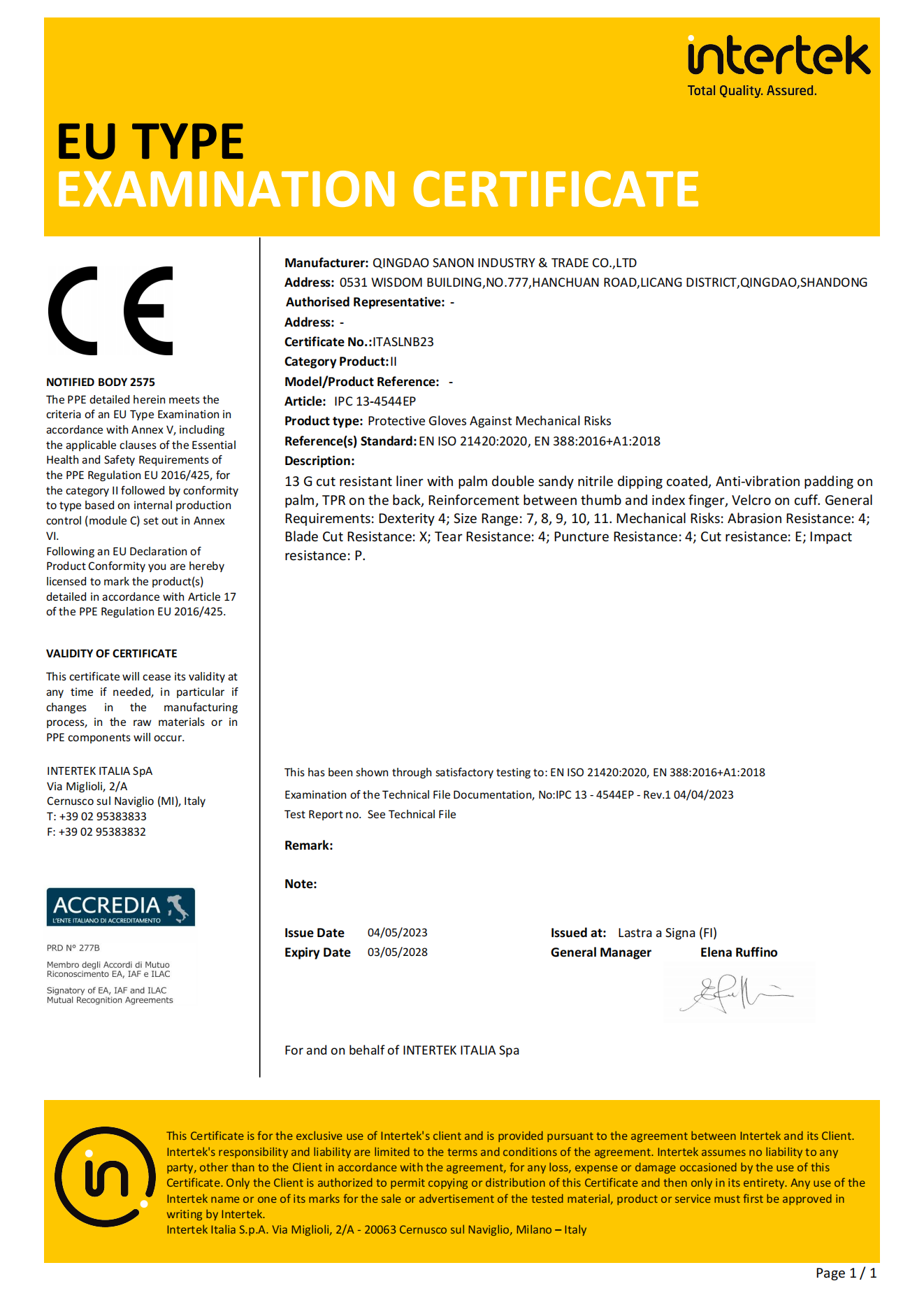
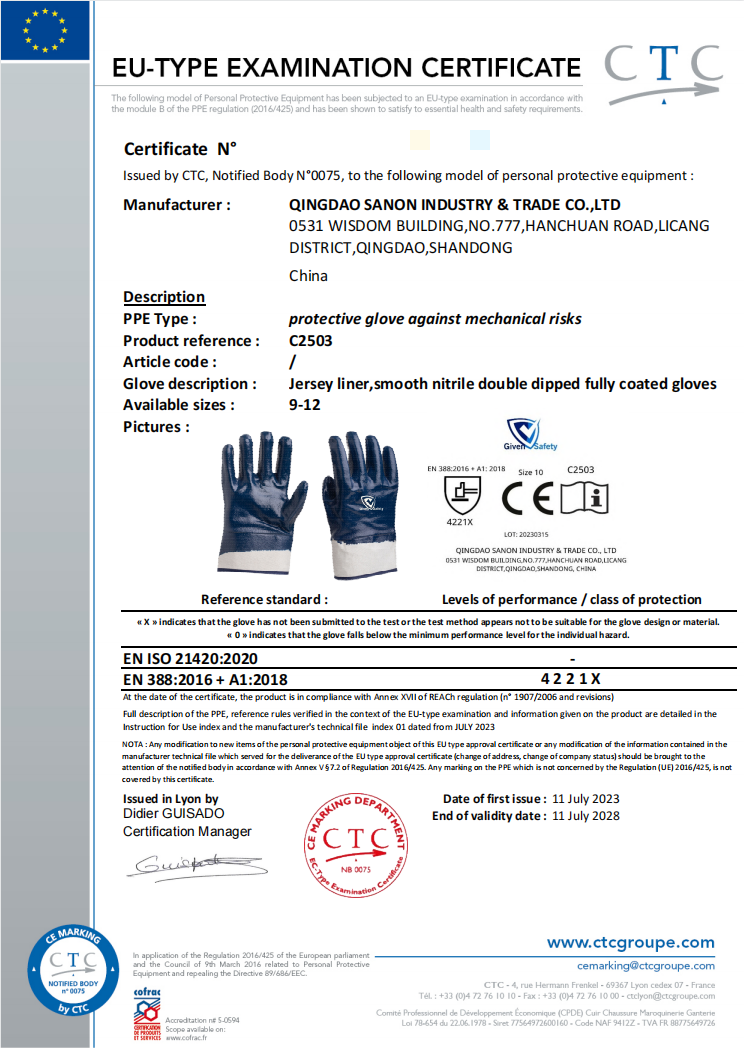
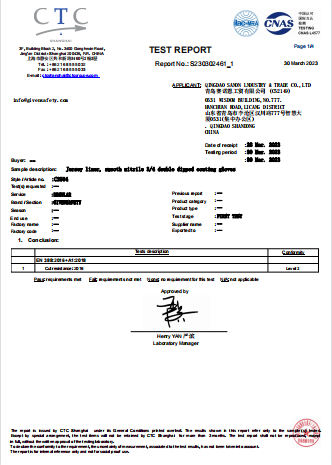
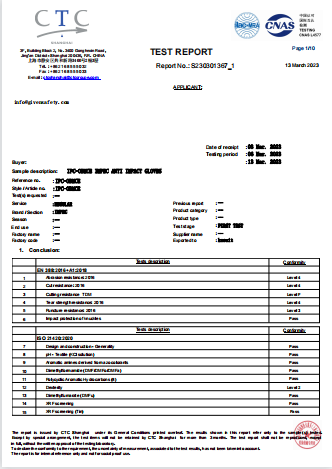
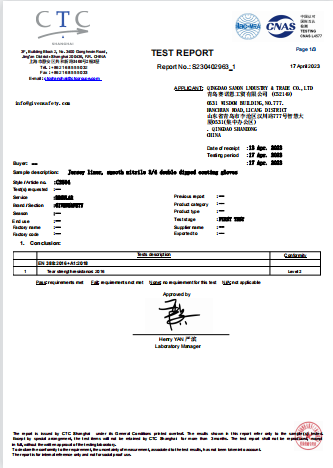
Excellent service
Provide professional services for importers, brand owners or distributors of cut resistant gloves.

Quick response
1. Our company offers a 7/24 hour online and offline service. You can reach us at any time and get a quick answer to your questions.
2. Free samples within 15 days.

Multiple custom glove solutions
1. Custom your cut proof gloves for different applications based on different yarns, coatings and glove shells.
2. Custom your cut resistant gloves for different functions based on different cut ratings, impact ratings, tear resistance, and abrasion resistance.

Flexible Payment Terms
1. Various payment terms according to the order quantity
2. We give TT 60 days or LC 60 days payment support for customers with annual transaction volume of USD 3 million or more.
Easily view our wide range of work Gloves
TOP 10 work gloves manufacturer & supplier in china
category
-
kevlar cut resistant gloves
-
13G tungsten micro foam nitrile A9 cut resistant gloves
-
13G sandy nitrile coated ANSI A5 cut resistant work gloves
-
13G sandy nitrile coated A6 cut resistant thermal gloves
-
13G sandy nitrile coated ANSI A3 cut resistant gloves
-
13G pu coated A2 cut resistant gloves
-
13G foam nitrile coated A8 cut resistant gloves
-
13G foam nitrile coated A4 cut resistant gloves
-
13G A5 cut resistant silicone coated gloves
Some Key Points About Cut Resistant Gloves
Here are some key points about our collaboration and anti cut gloves.
These points were summarized by Givensafety, which has more than 15 years of experience in the production of cut resistant gloves.
If you would like to learn more about our capabilities and cut resistant gloves, please continue reading.
FAQ
Can you provide free samples of cut resistant gloves?
Yes, We can provide free sample to you.
At Givensafety, we understand the importance of evaluating the quality and performance of our gloves before placing the bulk. This allows you to test our gloves firsthand and assess their suitability for your specific needs.
Contact us to discuss the best options for obtaining samples of our cut-resistant gloves.
How Long Does it Take To Send Samples?
We will design and making the sample based on your requirement.
Usually it takes 10-15days to send the samples to you.
What is The Minimum Order Quantity For Cut Resistant Gloves?
Usually our MOQ is 500 dozens for each order.
Can you produce the cut resistant gloves with reinforcement between crotch?
Yes, we can do thumb reinforcement in order to extend the service life of the cut resistant gloves. Regular thumb reinforcement or extended thumb reinforcement can be done according to your requirements.
What are the cost components of cut resistant gloves?
During the production process of cut resistant gloves, the choice of materials significantly affects the price.
For example, in terms of yarn, different cut resistant yarns such as HPPE fiber, steel fiber, glass fiber, and Kevlar have varying quality grades (A-grade and B-grade), each with a different price. This directly influences the price of cut resistant gloves.
Furthermore, the cut level also affects the price. Gloves with lower cut resistance levels are typically cheaper, while those with higher cut resistance levels are more expensive.
In addition, different types of coatings or treatments on the gloves also impact the price. For example, gloves with a PU coating tend to be cheaper compared to gloves with a nitrile sandy coating, which may be more expensive.
Moreover, gloves with the same coating can have different prices depending on whether the materials used are domestically produced in China or imported. Domestically produced coatings are usually cheaper, while imported coatings tend to be more expensive.
It’s important to note that price often reflects quality. If you choose a supplier with lower prices, you may need to compromise on the glove’s tactile sensation and lifespan.
Overall, the pricing of cut resistant gloves is influenced by factors such as the choice of yarn, cut level, type of coating, and the origin of materials.
What Are The Advantages Of Your Cut Resistant Gloves?
Our cut resistant gloves offer numerous advantages that set them apart in terms of quality, performance, and user experience. Here are the key advantages of our cut-resistant gloves:
- Superior Cut Protection: Our gloves are engineered with advanced materials and technologies to provide exceptional cut protection. They are designed to resist sharp edges and blades, reducing the risk of injuries in various industries and applications.
- Enhanced Comfort: We prioritize wearer comfort, ensuring our gloves offer a snug and ergonomic fit. They are designed to allow for flexibility and dexterity, enabling users to perform tasks with ease while maintaining optimal hand movement.
- Durability and Longevity: Our cut-resistant gloves are built to withstand rigorous use and challenging work environments. They exhibit excellent resistance against abrasions, tears, and punctures, ensuring they can withstand demanding tasks and offer extended product life.
- Breathability and Moisture Management: We understand the importance of breathability in gloves, especially during prolonged wear. Our gloves incorporate breathable materials and ventilation features to promote airflow, reducing sweat buildup and enhancing user comfort.
- Versatility and Customization: Our range of cut-resistant gloves covers various cut levels, glove types, and sizes to cater to diverse industry requirements. We also offer customization options such as logo printing and color choices, allowing you to personalize the gloves to suit your brand or organizational needs.
- Compliance with Industry Standards: Our cut-resistant gloves comply with relevant industry standards and certifications, assuring you of their quality and performance. They meet or exceed the requirements set by organizations such as ANSI (American National Standards Institute) and EN (European Norms).
- Reliable Customer Support: We take pride in providing excellent customer support and assistance. Our knowledgeable team is available to address your inquiries, provide guidance on glove selection, and offer any assistance you may require throughout your experience with our products.
By choosing our cut-resistant gloves, you gain access to superior protection, comfort, durability, and customization options, backed by our commitment to quality and customer satisfaction. Experience the advantages of our cut-resistant gloves and elevate safety in your workplace.
How Many Types Of Cut Resistant Gloves Are There?
There is a variety of cut-resistant gloves available, each designed to meet specific needs and provide varying levels of protection against cuts and lacerations. Here are different types of cut-resistant gloves commonly used:
High-Performance Fiber Gloves: These gloves are made from high-performance fibers like Kevlar or Aramid, which offer exceptional cut resistance. They provide reliable protection against sharp edges and are suitable for tasks involving moderate to high cut risks.
Composite Yarn Gloves: Composite yarn gloves combine different materials, such as HPPE, stainless steel, glass fiber, nylon, spandex or diamond yarn, to enhance their cut resistant properties. In order to provide additional grip, durability or abrasion resistance, different coatings like nitrile, pu or latex are used on palm and fingers. These cut resistant gloves offer a balance between cut protection, dexterity, and comfort., making them ideal for a range of industries.
Metal Mesh Gloves: Metal mesh gloves consist of interlocking metal rings that form a protective barrier against cuts and punctures. They are commonly used in industries with extreme cut hazards, such as meat processing or butchery.
Dotted Gloves: Dotted gloves have cut-resistant material on the palm and fingers, along with small dots or patterns made from materials like PVC or rubber. These dots enhance grip and allow for better handling of objects, making them suitable for tasks requiring dexterity and slip resistance.
It is important to consider the specific cut risks and requirements of your work environment when selecting the appropriate type of cut-resistant gloves. Assessing the level of cut protection needed and consulting with experts or suppliers can help you choose the gloves that best meet your safety needs.
What Material/Fabric is Usually Used For Cut Resistant Gloves?
Cut-resistant gloves are typically made from various materials and fabrics that offer high strength and resistance to cuts. The following materials are commonly used in the production of cut-resistant gloves:
Kevlar: Kevlar is a well-known and widely used synthetic fiber that provides excellent cut resistance. It is lightweight, durable, and five times stronger than steel on an equal-weight basis. Kevlar® is often blended with other materials to enhance its cut-resistant properties.
HPPE: High-performance polyethylene is a thermoplastic polyethylene fiber, which provides maximum strength cut resistance with minimum weight. HPPE has good cut resistance and wear resistance. Most cut-resistant glove materials now contain HPPE.
Glass Fiber: Glass fibers are sometimes incorporated into cut-resistant gloves to enhance their strength and cut resistance. These fibers provide additional reinforcement and improve the gloves’ ability to withstand sharp objects.
Stainless Steel: Stainless steel wires or strands are used in gloves that require the highest level of cut resistance. They provide excellent protection against cuts and punctures from sharp objects and are commonly used in industrial applications where extreme cut hazards are present.
Aramid Fibers: Aramid fibers, such as Technora® or Nomex®, are used in cut resistant gloves due to their high strength and heat resistance. These fibers offer reliable cut protection and are often used in applications where thermal hazards are a concern.
These materials are selected for their specific properties, including high tensile strength, resistance to cuts and abrasions, and flexibility. Manufacturers may use a combination of these materials or incorporate additional coatings or reinforcements to enhance grip, durability, and overall performance of the gloves.
Cut Resistant Gloves Levels
Cut-resistant gloves are classified into different levels to indicate their ability to withstand cuts from sharp objects. These levels are determined through standardized testing methods and provide an easy way to compare the cut resistance of different gloves. The two commonly used standards for cut resistance are the ANSI/ISEA (American National Standards Institute/International Safety Equipment Association) and the EN388 (European Norms) standards.
The cut resistance levels are typically represented by numerical values or letters, indicating the level of protection offered by the gloves. Here is an overview of the cut resistance levels:
ANSI/ISEA105(2016) Cut Resistance Levels:
Level A1 to A9: These levels range from A1 (lowest) to A9 (highest) and are based on the amount of force required to cut through the glove material. A higher ANSI/ISEA level signifies greater cut protection.
EN 388 Cut Resistance Levels:
Level A to F: The EN 388 standard uses a scale from A (lowest) to F (highest) to indicate the gloves’ resistance to cuts. The rating is based on the number of cycles required to cut through the material using a standardized blade. A higher EN 388 level indicates increased cut resistance.
It is important to consider the specific requirements of your work environment and the level of cut hazards involved when selecting cut-resistant gloves. Understanding the applicable standards and consulting with safety professionals or glove suppliers can help you choose the gloves that provide adequate protection for your specific needs.
Kevlar Cut Resistant Gloves
Kevlar gloves have extraordinary cut resistance and wear resistance, and can protect hands from being cut by sharp metal, glass, porcelain, etc.
The types of Kevlar gloves include Kevlar wire gloves, Kevlar leather gloves (cowhide), Kevlar coated gloves (latex), Kevlar dotted gloves, etc. Different glove types can be selected according to different use environments.
How To Choose Cut Resistant Gloves?
When it comes to choosing cut-resistant gloves, there are several factors to consider in order to make the right decision. Here are some key points to guide you in selecting the most suitable cut resistant gloves:
- Assess the Level of Cut Hazards: Begin by evaluating the specific risks and hazards associated with your work environment. Identify the potential sources of cuts and determine the severity and frequency of these hazards. This will help you understand the level of cut resistance required for the gloves.
- Understand Cut Resistance Ratings: Familiarize yourself with the different rating systems used to indicate the level of cut resistance, such as ANSI/ISEA or EN standards. These ratings provide a standardized way to compare the performance of various gloves. Make sure to consider the appropriate standard for your region and industry.
- Consider the Material and Construction: Look for gloves made from high-quality materials known for their cut-resistant properties, such as Kevlar, HPPE. Additionally, examine the construction of the gloves, paying attention to features like reinforced stitching or coatings that can enhance their cut resistance.
- Evaluate Comfort and Dexterity: Comfort and dexterity are crucial factors in selecting cut-resistant gloves. Consider gloves that provide a good fit, allowing for easy movement and flexibility. Look for features like seamless designs or breathable materials that enhance comfort during extended use.
- Verify Proper Sizing: Ensure that the gloves are available in a range of sizes to accommodate different hand sizes. Ill-fitting gloves can hinder dexterity and compromise overall safety. Refer to the manufacturer’s sizing guide to determine the best fit for your hands.
By considering the level of cut hazards, understanding rating systems, evaluating materials and construction, seeking recommendations, and testing gloves, you can make an informed choice that provides the necessary protection and comfort for your specific needs.
The easiest way: Tell us your needs, and givensafety will help you make the most correct decision. Contact Us Now!
Givensafety gloves
As a superior cut resistant gloves company, we custom or wholesale cut resistant gloves in bulk. If you are looking for a better supplier of cut proof gloves, please feel free to contact us. We will use our advanced technology and manufacturing experience to produce best cut resistant gloves for you within your budget.

